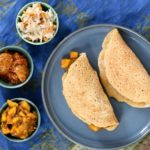Lentil and Millet Dosas
Dosa are South Indian crepes made from fermented grains. These lentil and millet dosa are a delicious alternative to the more traditional rice dosa. They are perfect for all sorts of different fillings. See the section above for 8 traditional and non-traditional options.
- Prep Time: 20 minutes
- Cook Time: 20 minutes
- Total Time: 40 minutes
- Yield: Serves 4
- Category: Snack
- Method: Fermented
- Cuisine: Indian
- Diet: Gluten Free
Ingredients
Scale
-
1 cup millet
-
1/4 cup red lentils
- 1 pinch of fenugreek seeds (optional, see notes)
- Water, chlorine-free (see notes)
-
1/2 tsp salt
- 1 Tbsp oil
Instructions
- Place the millet, lentils, and fenugreek in a large glass bowl or measuring cup. Cover with 2 cups of water and leave them to soak for 3-6 hours.
- After soaking, drain the excess water (whatever is easy to pour off) and scrape the mixture into a blender. Grind until smooth and frothy. You may need to add a bit of water to assist with the blending, however, it should be quite thick.
- Scrape everything back into the large glass container for fermenting. The container needs to have enough room for the dosa batter to double in size.
- Cover the container with a tea towel, place it somewhere warm (like above the refrigerator). Let it ferment for at least 12 hours or up to 48 hours. Stir once or twice during the ferment. Ideally, the dosa batter will double in size, however, you can cook the dosas whenever it is convenient.
- When you are ready to cook the dosa, add the salt to the dosa batter. You will also need to add a bit more water. The goal is to have a thick, pourable consistency. If this is your first time making dosa, start with just 3 Tbsp of water, and slowly add more.
- Heat a frying pan on medium. When it is warm, put a little oil in the pan, then ladle a spoonful of batter into the pan. Use the back of the spoon to spread the batter out into a thin layer. I typically make smaller dosas using 1/4 cup of batter, since they are easier to flip.
- The dosa is cooked when the bottom has started to brown and the top side is dry. You can either serve it like this or flip the dosa over to lightly cook the other side. You want the dosa to be fully cooked, but still soft enough to fold and roll.
- Serve dosas hot from the pan with your choice of fillings. (See the section above for 8 suggestions).
Notes
- I haven’t included exact measurements for water in this recipe, because it depends on how much water you need to get it well blended in your blender. I include about 3 Tbsp of water in the ferment. Then I add about 6 Tbsp of water to the batter before cooking the dosa.
- The amount of time it will take your dosa batter to double is dependent on temperature and local strains of yeast. Unlike bread, the precise doubling of the batter isn’t required, so just cook the dosas whenever you want. However, leaving the batter to ferment for too long will result in a VERY sour-tasting dosa.
- Leftover dosas can be quickly reheated in a hot frying pan to refresh their crisp texture.
- Fenugreek is thought to help capture the wild yeasts, however, it’s not necessary for this recipe to work. I have made dosas with and without the addition of fenugreek.
Find it online: https://www.fermentingforfoodies.com/lentil-and-millet-dosas/
